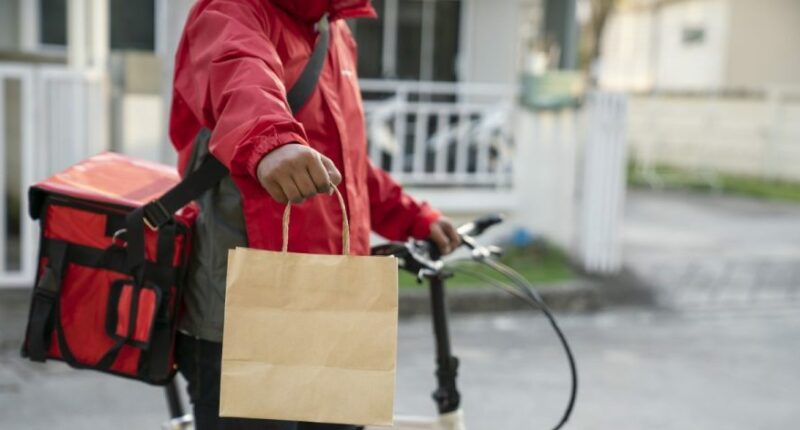Share this @internewscast.com

(NerdWallet) – It’s lunchtime and you work from home. There’s only a few things in the fridge, and you just can’t bring yourself to cook eggs again.
Time to tap that delivery app and order something. What do you have to lose?
“Well, how long do you want to be working?” asks Valerie A. Rivera, a certified financial planner in Chicago and founder of FirstGen Wealth.
She makes sure her clients understand how seemingly minor spending habits, such as opting for delivery multiple times a week, can significantly accumulate over time. Unfortunately, it’s not in a favorable way.
The cost of convenience can derail your money goals, she says. Once you run the numbers, you might just decide to break the habit.
Ordering delivery is what we do now
The cost of dining out has surged by 3.9% over the past year and continues to climb. In August, it increased by 0.3%, based on data from the U.S. Bureau of Labor Statistics.
Yet we continue to use services like DoorDash, Grubhub and Uber Eats on the regular even though it makes already-pricey food pricier.
The pandemic made online food ordering a necessity, and many have become accustomed to it. According to a January 2025 study by YouGov, an online research and analytics firm, over a quarter of Americans (28.2%) utilize these services at least weekly.
Buying a $10 sandwich might seem insignificant. However, when you factor in service fees and a tip for the driver, your total can easily exceed $20.
But how much you spend may surprise you
Rivera emphasizes the importance of understanding your finances to initiate change. She assists clients with a worksheet that meticulously examines their monthly expenditures to pinpoint exactly where their money is spent.
She says after housing and childcare, the third-largest expense she often sees is food delivery.
But even if it’s not in your top three, a couple hundred bucks a month can have an impact.
Candice Burch is a licensed mental health counselor and busy mom based in Sarasota, Florida, who said she orders DoorDash at least once a week.
“At the moment, the convenience seems worth the price, but when I tally it up, I realize that money could be better spent on things I care about more, like my daughter or family activities,” Burch explained in an email.
What is convenience costing you?
You may find that you can’t have your daily delivery and a diversified portfolio, too.
“We have to make trade-offs constantly with how we spend our dollars, how we spend our time and how we spend our energy,” Rivera says.
Spending hundreds a month on takeout for convenience today can set you back for tomorrow.
Maybe it’s a vacation, a home renovation or the option to retire early.
When it comes to building wealth, it’s often more about how much you spend, than how much you earn, Rivera says.
“What if you redirected $50 every month that was going to Chinese takeout and put it toward an account for a Disney vacation fund?”
Her point is that it’s easy to overspend on frivolous things — we all do it — but it’s not that hard to say “no” and save the money for something more meaningful.
Whipping up a cheese omelet won’t feel so imposing if you have a future-focused mindset.
For some people, it’s worth it
Michael Benoit said he works long hours and often relies on delivery apps for office lunches and dinners at home.
“On average, I spend about $800 each month, mostly through Uber Eats and DoorDash,” Benoit, who owns a company that provides contractor bonds in San Diego, said in an email interview.
“I see the charge in my monthly statement and it stands out compared to other discretionary expenses, but the tradeoff has always been the time I get back to manage my workload,” he said.
Ordering restaurant food feels more like a semi-discretionary expense for Ashleigh Beadle, who is getting her relatively new consulting business off the ground in Fairfield, Connecticut.
“I am known as the queen of Uber Eats in my neighborhood and family,” she says.
She says she orders delivery eight to 10 times a week because she is busy with work and her son, and doesn’t cook. She makes it more cost effective by stretching meals to more than a day, and says she has a relatively small grocery bill as a result.
It does work for some people, says Rivera.
“If it’s not interfering with your ability to save, then by all means.”
Others might want to think before they order
For most people though, Rivera says this type of lifestyle creep does impede saving in other areas. Once you break the habit, you can pay yourself.
“Think of yourself as a bill,” she says.
The way she describes it, it’s that simple. You look at your expenses and commit to cutting back.
“If you’re eating out seven times a week, can you try four?”
Then put what you plan to save in a high-yield savings account. Make it automatic every month to make it easy, she says.
How will you know if your savings strategy is working? Well, can you cover the bill to yourself at the beginning of the month and still pay the bills for everything else?
“That’s the ultimate test,” says Rivera.
So maybe don’t tap that delivery app. Because how long do you want to be working?

















